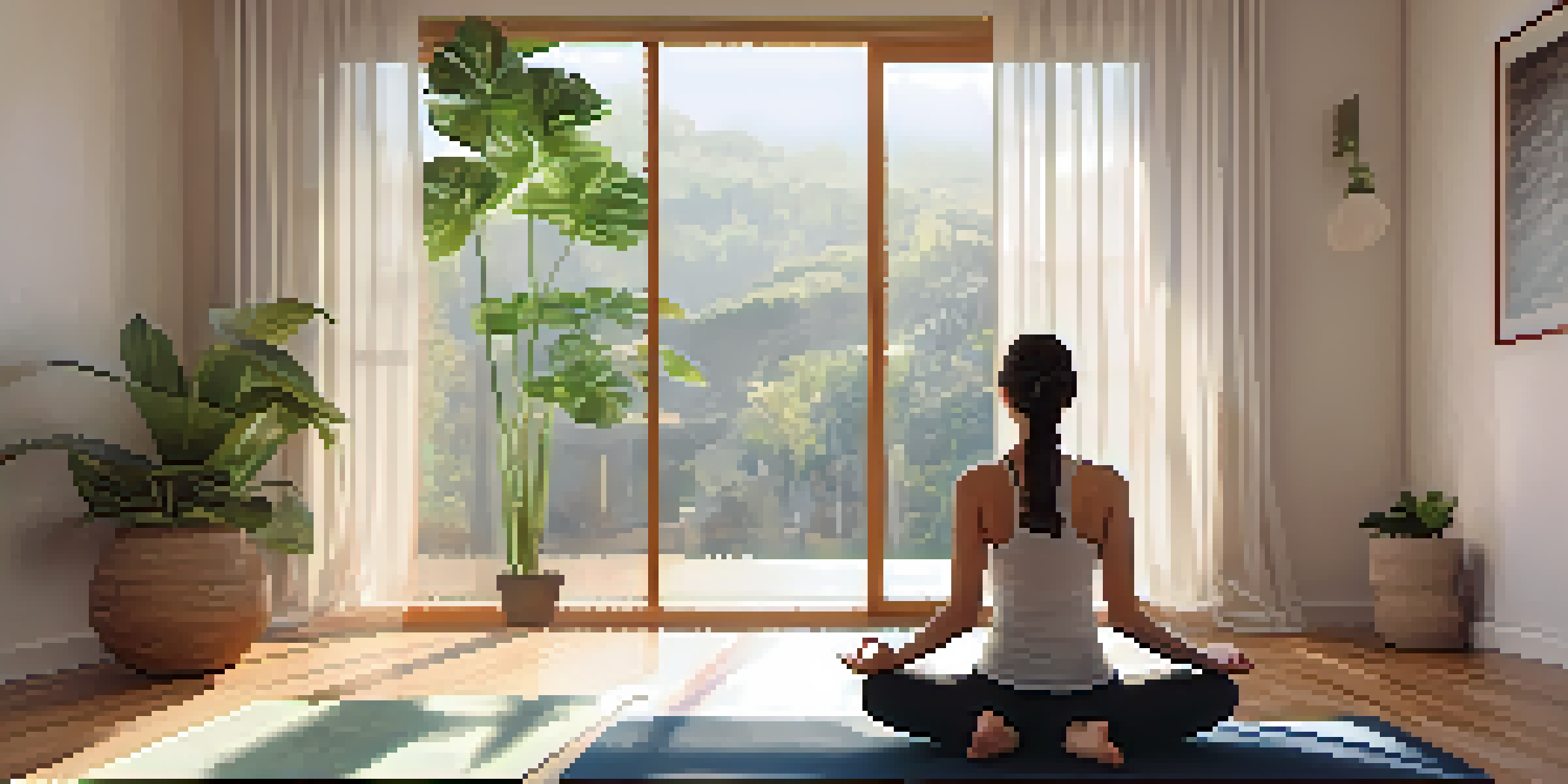Breathing Techniques: Naturopathic Approaches to Relaxation

Understanding the Importance of Breath in Naturopathy
Breathing is more than just a biological function; it plays a crucial role in our overall health. In naturopathy, the breath is seen as a bridge between the mind and body, helping to regulate emotions and stress levels. By focusing on our breathing, we can tap into a powerful tool for relaxation and well-being.
The breath is the bridge between the body and the mind.
Many people overlook their breath, taking shallow, rapid breaths that can lead to increased anxiety and fatigue. Naturopathic approaches encourage deeper, more mindful breathing, which can help ground us and promote a sense of calm. This shift in our breathing patterns can be transformative, helping to alleviate tension and anxiety.
Think of your breath as an anchor. When you focus on taking slow, deep breaths, you’re not only calming your nervous system but also creating space for clarity and mindfulness. This foundational practice is key in exploring various breathing techniques.
Diaphragmatic Breathing: A Simple Yet Powerful Technique
Diaphragmatic breathing, often referred to as 'belly breathing,' is a technique that emphasizes using the diaphragm effectively. This method encourages deeper intake of air, which can enhance oxygen flow throughout the body, leading to relaxation. Imagine filling your belly with air like a balloon; this visual can help you engage the diaphragm fully.

To practice this technique, find a comfortable position—sitting or lying down. Place one hand on your chest and the other on your abdomen. As you breathe in through your nose, aim to expand your belly while keeping your chest relatively still. This practice not only calms the mind but also increases lung capacity over time.
Breath: A Tool for Wellness
Focusing on our breath can significantly enhance relaxation and emotional well-being.
Incorporating diaphragmatic breathing into your daily routine can be a game changer. Even just a few minutes of practice can reduce stress and promote a sense of tranquility, making it a favorite among naturopathic practitioners.
Box Breathing: A Method for Stress Relief
Box breathing, also known as square breathing, is a structured technique that can help reduce stress and enhance focus. The method involves inhaling, holding, exhaling, and holding your breath again, each for a count of four. This rhythmic pattern creates a sense of balance and control, making it especially useful in high-pressure situations.
Breath is the link between the body and the mind; it’s the key to tranquility.
To practice box breathing, start by exhaling completely to empty your lungs. Inhale through your nose for four counts, hold for four counts, exhale through your mouth for four counts, and hold again for four counts before repeating. Visualize a square as you go through each step, which can help reinforce the rhythm.
Many find that using box breathing before a big presentation or stressful event can significantly calm their nerves. It’s like hitting a reset button, allowing you to approach challenges with a clearer, more focused mind.
Alternate Nostril Breathing: Balancing Energy
Alternate nostril breathing, or Nadi Shodhana, is a yogic practice that balances the body's energies and promotes relaxation. This technique involves closing one nostril while inhaling through the other, then switching sides. It’s believed to harmonize the left and right hemispheres of the brain, fostering a sense of peace and clarity.
To practice, sit comfortably and use your right thumb to close your right nostril. Inhale deeply through your left nostril, then close it with your ring finger while releasing your thumb to exhale through the right nostril. Repeat this process, ensuring smooth transitions between breaths.
Simple Techniques for Stress Relief
Breathing techniques like diaphragmatic and box breathing can effectively reduce stress and improve focus.
Many practitioners report feeling more centered and balanced after just a few rounds of alternate nostril breathing. It’s a great technique to incorporate into your daily routine, helping to alleviate stress and enhance mental clarity.
The 4-7-8 Breathing Technique: Promoting Deep Relaxation
The 4-7-8 breathing technique is designed to promote deep relaxation and is especially helpful for those struggling with sleep. Developed by Dr. Andrew Weil, this method involves inhaling for four seconds, holding the breath for seven seconds, and exhaling for eight seconds. This rhythmic breathing pattern helps calm the nervous system and reduce anxiety.
To practice, find a comfortable position and close your eyes. Inhale quietly through your nose for four seconds, hold your breath for seven seconds, and then exhale completely through your mouth for eight seconds, making a whooshing sound. Repeat this cycle four times, gradually increasing as you become more comfortable.
Many find that the 4-7-8 technique not only helps them relax but also improves their sleep quality. It’s a simple yet effective way to wind down after a long day, making it a valuable addition to your relaxation toolkit.
Integrating Breathing Techniques into Daily Life
Incorporating breathing techniques into your daily routine can enhance your overall well-being. Start by setting aside a few minutes each day for focused breathing exercises. Whether it's first thing in the morning or right before bed, creating a habit can lead to lasting benefits for your mental and physical health.
You might also consider pairing breathing exercises with other activities, such as yoga or meditation. This combination can amplify the calming effects, helping you feel more centered throughout your day. Just like watering a plant, nurturing your breath can lead to growth in your overall sense of peace.
Consistency Enhances Benefits
Integrating breathing exercises into daily life promotes lasting improvements in mental and physical health.
Remember, consistency is key. As you integrate these techniques into your life, you’ll likely notice a shift in your stress levels and emotional resilience, making you better equipped to handle life’s challenges.
Conclusion: The Power of Breath for Relaxation
Breathing techniques are a powerful, natural way to enhance relaxation and promote overall well-being. By understanding and practicing these methods, you can tap into a valuable resource that supports both mental and physical health. Just as a tree relies on its roots for stability, we too can find strength through our breath.
As you explore these techniques, remember to approach them with curiosity and patience. Everyone's experience with breathing exercises will differ, so find what resonates with you and make it a part of your daily routine. Over time, you’ll likely notice not only improved relaxation but also greater emotional balance.

In a world filled with stress and chaos, prioritizing your breath can be a transformative act of self-care. Embrace the power of your breath, and allow it to guide you toward a more relaxed and centered life.